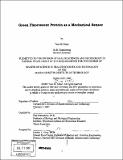Green fluorescent protein as a mechanical sensor
Author(s)
Muso, Taro M. (Taro Michael)
DownloadFull printable version (24.19Mb)
Alternative title
GFP as a mechanical sensor
Other Contributors
Harvard University--MIT Division of Health Sciences and Technology.
Advisor
Paul Matsudaira.
Terms of use
Metadata
Show full item recordAbstract
Inquiry into intracellular and cytoskeletal mechanics requires an intracellular mechanical sensor to verify models of sub-cellular structure dynamics. To this end, the green fluorescent protein (GFP) is considered as a mechanical sensor candidate with many desirable characteristics. Implicit solvent molecular dynamics CHARMM simulations demonstrated details inaccessible by AFM and OT methods, such as the linkage dependency of fluorophore environment changes and the energy exchanges between protein components during protein unfolding. Theoretical considerations and in vitro experiments explored the parameters important to GFP conjugation by N-hydroxysuccinimide (NHS) ester chemistry, and the complexities associated with a polymer approach to a controlled distribution of force across fluorescent proteins in a polyacrylamide (PAM) gel.
Description
Thesis (S.M.)--Harvard-MIT Division of Health Sciences and Technology, 2007. Includes bibliographical references (p. 133-141).
Date issued
2007Department
Harvard University--MIT Division of Health Sciences and TechnologyPublisher
Massachusetts Institute of Technology
Keywords
Harvard University--MIT Division of Health Sciences and Technology.